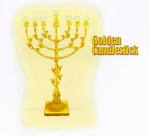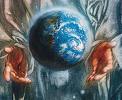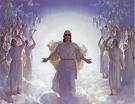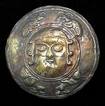
| Next | Previous | Index | Tellout Home |
6. Son of Man
Revelation 1.12-16
"I turned around to see the voice that was speaking to me. And when I turned, I saw seven golden lampstands, and among the lampstands was someone like a son of a man dressed in a robe reaching down to his feet and with a golden sash around his chest. The hair on his head was white like wool, as white as snow, and his eyes were like blazing fire. His feet were like a glowing bronze furnace, and his voice was a rushing water sound. He held seven stars in his right hand, and coming out of his mouth was a sharp, double-edged sword. His face was like the sun shining brilliantly." (Revelation 1.12-16) ✞
Seven Golden Lampstands
 The Apostle John turns to "see the voice" and observes instead "seven golden lampstands." He must have been somewhat surprised to see not a person but lampstands instead. The seven Temple or Tabernacle lampstands are called "Menorah" made of solid gold with seven branches, three on one side, three on the other, and a central one. Exodus 25.31-37 describes these lampstands lighting the Holy Tabernacle. The Temple furnishings instructions read, "Make a pure gold lampstand. Hammer out its base and shaft, and make its flower-like cups, buds, and blossoms of one piece. Six branches are to extend from the lampstand sides - three on each side." "Hammer out of one piece of pure gold the buds, branches, and the lampstand." ✞
The Apostle John turns to "see the voice" and observes instead "seven golden lampstands." He must have been somewhat surprised to see not a person but lampstands instead. The seven Temple or Tabernacle lampstands are called "Menorah" made of solid gold with seven branches, three on one side, three on the other, and a central one. Exodus 25.31-37 describes these lampstands lighting the Holy Tabernacle. The Temple furnishings instructions read, "Make a pure gold lampstand. Hammer out its base and shaft, and make its flower-like cups, buds, and blossoms of one piece. Six branches are to extend from the lampstand sides - three on each side." "Hammer out of one piece of pure gold the buds, branches, and the lampstand." ✞
Solomon's Great Temple
 "The golden lampstands" are also pictured in Solomon's Great Temple. According to Zechariah 4.2, "a solid gold lampstand with a top bowl and seven lamps on it, with seven lamp channels." Revelation's seven golden lampstands probably refered to the seven churches in Revelation 1.11. The seven churches were Ephesus, Smyrna, Pergamum, Thyatira, Sardis, Philadelphia, and Laodicea. God calls each church to bring the Gospel light to their area. ✞
"The golden lampstands" are also pictured in Solomon's Great Temple. According to Zechariah 4.2, "a solid gold lampstand with a top bowl and seven lamps on it, with seven lamp channels." Revelation's seven golden lampstands probably refered to the seven churches in Revelation 1.11. The seven churches were Ephesus, Smyrna, Pergamum, Thyatira, Sardis, Philadelphia, and Laodicea. God calls each church to bring the Gospel light to their area. ✞
Son of Man
 Jesus, Revelation's Son of Man, stands among the golden lampstands in a long white robe and a golden sash around his chest. The prophet Daniel also tells of a "Son of Man." Daniel 7.13 explains, "In my night vision, I looked, and there before me was a son of man coming with the heavenly clouds." Interestingly, Jesus adopted the "Son of Man" title for himself during his earthly ministry. In Mark 8.31, we read, "Jesus then began to teach them that the Son of Man must suffer many things." In Mark 8.38, Jesus also says, "If anyone is ashamed of me and my words in this adulterous, sinful generation, the Son of Man will be ashamed of them when he comes in his Father's glory with the holy angels." ✞
Jesus, Revelation's Son of Man, stands among the golden lampstands in a long white robe and a golden sash around his chest. The prophet Daniel also tells of a "Son of Man." Daniel 7.13 explains, "In my night vision, I looked, and there before me was a son of man coming with the heavenly clouds." Interestingly, Jesus adopted the "Son of Man" title for himself during his earthly ministry. In Mark 8.31, we read, "Jesus then began to teach them that the Son of Man must suffer many things." In Mark 8.38, Jesus also says, "If anyone is ashamed of me and my words in this adulterous, sinful generation, the Son of Man will be ashamed of them when he comes in his Father's glory with the holy angels." ✞
Jesus' Title
Using the title "Son of Man," John of Patmos clarifies that Revelation originates from the Lord Jesus Christ himself. Jesus walked and talked with John in Galilee many years before. The "Son of Man" title he used for himself during his time on earth refers to his humanity and ministry with people. He employs a vague phrase, meaning "human being," from the Old Testament and injects new meaning into it. In heaven, Jesus still opens the way for all to enter Almighty God's presence. ✞
Long White Robe
 Revelation's Son of Man wears a "robe to his feet." The same Greek word is used of the High Priest's robes in the Tabernacle and Temple in Exodus 28.4. "These are the garments they are to make: a breastpiece, an ephod, a robe, a woven tunic, a turban, and a sash." Jesus commences his priestly work, dressed in a long white robe with a golden sash around his chest. The Roman Jewish historian Flavius Josephus (37-100 AD), also known as "Josephus," was a gifted scholar. He was born in Jerusalem of a priestly family and described in detail in "The Antiquities of the Jews 3.7.2,4" the High Priest's clothing in the Jerusalem Temple before its 70 AD destruction. He wrote, "This High Priestly vestment reaches down to the feet, sits close to the body, and has sleeves tied fast to the arms. It is girded to the breast a little above the elbows, by a girdle often going round, four fingers broad, but so loosely woven, that you would think it was a serpent's skin." ✞
Revelation's Son of Man wears a "robe to his feet." The same Greek word is used of the High Priest's robes in the Tabernacle and Temple in Exodus 28.4. "These are the garments they are to make: a breastpiece, an ephod, a robe, a woven tunic, a turban, and a sash." Jesus commences his priestly work, dressed in a long white robe with a golden sash around his chest. The Roman Jewish historian Flavius Josephus (37-100 AD), also known as "Josephus," was a gifted scholar. He was born in Jerusalem of a priestly family and described in detail in "The Antiquities of the Jews 3.7.2,4" the High Priest's clothing in the Jerusalem Temple before its 70 AD destruction. He wrote, "This High Priestly vestment reaches down to the feet, sits close to the body, and has sleeves tied fast to the arms. It is girded to the breast a little above the elbows, by a girdle often going round, four fingers broad, but so loosely woven, that you would think it was a serpent's skin." ✞
Golden Sash
 Josephus continues to describe the girdle as "embroidered with flowers of scarlet, purple, blue, and fine twined linen, but the warp was nothing but fine linen. Its wrapping began at the breast and tied when it had gone round often. The white robe hung loosely down to the ankles." Imagine Jesus robed in this way! Jesus is the High Priest "par excellence." ✞
Josephus continues to describe the girdle as "embroidered with flowers of scarlet, purple, blue, and fine twined linen, but the warp was nothing but fine linen. Its wrapping began at the breast and tied when it had gone round often. The white robe hung loosely down to the ankles." Imagine Jesus robed in this way! Jesus is the High Priest "par excellence." ✞
Important Peoples' Clothing
 Important people, priests, princes, and kings in both Testaments, like the Jerusalem Temple's High Priest, wore long white robes and golden sashes. 1 Samuel 24.5 and 11 described King Saul's and his son Jonathan's clothing in this way. Jesus' the risen Son of Man's ascension robes were also "royal garments." In heaven, people no longer view Jesus as a criminal on a cross. He is now elegantly dressed like a victorious king and pre-eminent High Priest. ✞
Important people, priests, princes, and kings in both Testaments, like the Jerusalem Temple's High Priest, wore long white robes and golden sashes. 1 Samuel 24.5 and 11 described King Saul's and his son Jonathan's clothing in this way. Jesus' the risen Son of Man's ascension robes were also "royal garments." In heaven, people no longer view Jesus as a criminal on a cross. He is now elegantly dressed like a victorious king and pre-eminent High Priest. ✞
Daniel's Vision
 Other Bible passages describe Jesus' long white robe in heaven. Daniel's vision in Daniel 10.5 illustrates how the divine figure arrives, "I looked up, and there was a man dressed in linen, with a fine gold belt from Uphaz around his waist." If this is Jesus' pre-incarnation appearance, the risen Lord's dress indicates his three-fold ministry on earth as a king, a priest, and a prophet. "Uphaz" is probably another name for the gold-producing center "Ophir" mentioned in Jeremiah 10.9. "Hammered silver brought from Tarshish and gold from Uphaz." God acknowledges power and authority in King Jesus. As a priest, Jesus is the way into God's presence. As a prophet, Jesus brings truth to human beings. ✞
Other Bible passages describe Jesus' long white robe in heaven. Daniel's vision in Daniel 10.5 illustrates how the divine figure arrives, "I looked up, and there was a man dressed in linen, with a fine gold belt from Uphaz around his waist." If this is Jesus' pre-incarnation appearance, the risen Lord's dress indicates his three-fold ministry on earth as a king, a priest, and a prophet. "Uphaz" is probably another name for the gold-producing center "Ophir" mentioned in Jeremiah 10.9. "Hammered silver brought from Tarshish and gold from Uphaz." God acknowledges power and authority in King Jesus. As a priest, Jesus is the way into God's presence. As a prophet, Jesus brings truth to human beings. ✞
Ancient of Days
 Jesus' hair is described as "white like wool as white as snow" in Revelation which is similar to Almighty God himself in Daniel 7.9, "As I looked, thrones appeared in place, and the Ancient of Days took his seat. His clothing was as white as snow, the hair of his head was white like wool." Daniel 3.17 reveals, "He approached the Ancient of Days and led me into his presence." Ancient of Days was the name given to the elderly figure appearing three times in the Book of Daniel. Interestingly, eastern 6th century Christian art sometimes portrayed Jesus as a white-haired older man with a long beard, the Ancient of Days, to symbolically show that Jesus existed from all eternity. "White hair" was the mark of a superior wise person with pure motives. Revelation explains that Jesus has "blazing fiery eyes," in Revelation 19.12, which indicates his all-knowing nature. ✞
Jesus' hair is described as "white like wool as white as snow" in Revelation which is similar to Almighty God himself in Daniel 7.9, "As I looked, thrones appeared in place, and the Ancient of Days took his seat. His clothing was as white as snow, the hair of his head was white like wool." Daniel 3.17 reveals, "He approached the Ancient of Days and led me into his presence." Ancient of Days was the name given to the elderly figure appearing three times in the Book of Daniel. Interestingly, eastern 6th century Christian art sometimes portrayed Jesus as a white-haired older man with a long beard, the Ancient of Days, to symbolically show that Jesus existed from all eternity. "White hair" was the mark of a superior wise person with pure motives. Revelation explains that Jesus has "blazing fiery eyes," in Revelation 19.12, which indicates his all-knowing nature. ✞
Sound of God's Voice
 In this passage, Jesus speaks with divine authority, and his voice sounds to John of Patmos, "like the sound of rushing water." What springs to mind is the roar of a magnificent waterfall going over Niagara's edge. If this were in Isrtael, it would have been one of the loudest sounds in Jesus' day, similar to a jet plane flying overhead today. Surprisingly, the most deafening animal sound recorded in nature is the whale. An even greater noise was generated in 1883 when the Krakatoa volcano erupted. It ejected 25 cubic kilometers of rock, ash, and pumice with a 180 decibels explosion into the air and carried it as far as Perth in Australia! It ruptured sailors' eardrums 40 miles away! A Saturn 5 rocket at takeoff is so intense that its noise at 185 decibels melts concrete! Compare that to a thunderstorm at 125 decibels, but Jesus' voice here no doubt seemed louder to John! ✞
In this passage, Jesus speaks with divine authority, and his voice sounds to John of Patmos, "like the sound of rushing water." What springs to mind is the roar of a magnificent waterfall going over Niagara's edge. If this were in Isrtael, it would have been one of the loudest sounds in Jesus' day, similar to a jet plane flying overhead today. Surprisingly, the most deafening animal sound recorded in nature is the whale. An even greater noise was generated in 1883 when the Krakatoa volcano erupted. It ejected 25 cubic kilometers of rock, ash, and pumice with a 180 decibels explosion into the air and carried it as far as Perth in Australia! It ruptured sailors' eardrums 40 miles away! A Saturn 5 rocket at takeoff is so intense that its noise at 185 decibels melts concrete! Compare that to a thunderstorm at 125 decibels, but Jesus' voice here no doubt seemed louder to John! ✞
Soldiers' Bronze Shoes
 This Revelation passage not only tells us about Jesus' voice but also about his feet. They were like "bronze glowing in a furnace." This idea may seem strange, but it explains a precious metal's color and glow. "Electrum" is one such silver and gold combination. The phrase "his feet were like bronze glowing" may also reference bronze soldier's shoes, the latest technology in the ancient Roman world. They protected a soldier's feet in battle and when on the march. ✞
This Revelation passage not only tells us about Jesus' voice but also about his feet. They were like "bronze glowing in a furnace." This idea may seem strange, but it explains a precious metal's color and glow. "Electrum" is one such silver and gold combination. The phrase "his feet were like bronze glowing" may also reference bronze soldier's shoes, the latest technology in the ancient Roman world. They protected a soldier's feet in battle and when on the march. ✞
Spiked
The Roman soldiers' shoes "were not like other shoes of the time, but made out of bronze or brass and leather." The Romans commonly used bronze for coins, ornaments, and even toiletry items like nail cleaners, tweezers, and toothpicks! Bronze Roman soldier's shoes comprised two parts, the upper part from the foot's top extending upwards across the shin to just below the knee. The shoe looked like a boot crafted of finely tooled brass formed to the soldier's calf. The shoe itself had two metal pieces on top and bottom. Thin brass parts covered the foot. The sides were held together by multiple pieces of leather. On the bottom, the shoes had dangerous spikes sometimes up to three inches in length." These spikes were a deadly weapon in close combat. ✞
Roman Gladius Sword
 Jesus' appearance "was like the sun shining in all its brilliance." His face's brightness indicated his divine majesty, like his glowing look at the Transfiguration. The sharp double-edged sword in Jesus' mouth intends us to realize his message contains power and judgment. It may also refer to the Roman foot soldiers' primary weapon in close battle combat. The double-edged sword as used by a gladiator was called a "gladius." ✞
Jesus' appearance "was like the sun shining in all its brilliance." His face's brightness indicated his divine majesty, like his glowing look at the Transfiguration. The sharp double-edged sword in Jesus' mouth intends us to realize his message contains power and judgment. It may also refer to the Roman foot soldiers' primary weapon in close battle combat. The double-edged sword as used by a gladiator was called a "gladius." ✞
"Son of Man"
by Ron Meacock © 2021
| ^Top Page | Next | Previous |